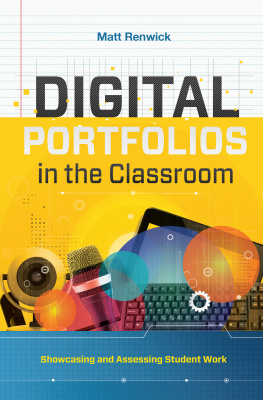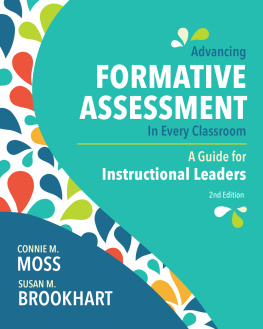Contents
Guide
Pages
Introduction
....................
Assessment is messy. I'm not referring to the standardized forms of assessment that are typical in schools today. The tools and results they produce are clean but show little more than a score or basic indicator of a student's current ability. The messiness I'm referring to includes the day-to-day, in-the-moment assessment that reveals information to inform teaching and learning. These assessments offer a more complete picture of a student's current abilities and dispositions. Indeed, assessment of this nature can reveal the student behind the symbols and numbers and tell his or her whole story.
Teachers know what this latter type of assessment looks and feels like, yet it can be hard to describe and capturehence the messiness. What assessment resembles in this context might be a frustrated look or a sense of excitement while working on a new project. I've found that when I ask teachers what they most enjoy about working in education, their responses usually reflect these types of moments:
- "When their eyes light up when they finally get something."
- "When that light bulb turns on."
- "When students can see how they've progressed over the course of the school year."
The purpose of this book is to provide a guide for teachers to capture, organize, analyze, and take action on the more discrete and qualitative pieces of information in the classroom. An abundance of 21st century tools now available offer opportunities for students to represent their learning that is more in line with their understanding. Digital portfolios offer one such opportunity. The documentation of audio, video, images, text, and creative content should be held in the same regard as their quantitative counterparts (Figure 0.1). It's the goal of this book to help educators use this information to drive their instruction. Teaching becomes more rewarding when we can experience the true impact of our instruction in ways that better illustrate the whole child.
Figure 0.1. Qualitative Versus Quantitative Data

With that in mind, digital portfolio assessment is an effective way to structure and analyze qualitative student learning results. This approach can help teachers embrace the messiness of teaching and learning in a way that better honors our craft. Digital portfolio assessment, when implemented successfully, can reveal a more complete description of our students as learners. In the process, parents and other teachers become partners in our students' learning journeys.
The organization of this book is intended to guide teachers toward building a comprehensive approach to using digital portfolios with students. We take it one step at a time. offers a definition plus a vignette of digital portfolio assessment in action. This description creates a context for unpacking the three types of portfoliosperformance (best work), progress (growth over time), and process (student reflections and experiences)and how they are difficult to categorize. A brief history of portfolio assessments is also examined. Through this understanding, we develop the foundation for assessment literacy that we explore in the following chapters.
In , I make the case for implementing digital student portfolios in schools. The rationale focuses on both academic reasons and social and emotional benefits of this more authentic approach to assessment. I also share a few words of caution. With any significant pedagogical or practical change, there is a certain level of departure from prior practice. However, I believe that any challenges associated with adopting a portfolio assessmentwith the help of technologyis worth the effort, especially considering the benefits.
In , we get started with using digital portfolios with students. Guidance is provided for how to assess the needs of your students, develop a yearlong plan for instruction, and select the digital tools to capture their best work within performance portfolios. This is a logical first step to implementing digital portfolios in the classroom. The success experienced at this stage can pave the way for integrating technology more powerfully in the future.
In , we delve deeper in portfolio assessments. Specifically, we look at how backward design, or planning with the end in mind, can be enhanced with progress, process, and performance portfolios. Instruction should be intentional to ensure that students arrive at essential understandings. This chapter offers suggestions for aligning portfolio assessment, both summative and formative, with standards. We will explore multiple examples of how a comprehensive portfolio assessment system can help teachers create more authentic pathways toward high-quality student learning outcomes.
In , I describe the larger process of going schoolwide with digital portfolios. In my first book on digital student portfolios (Renwick, 2014), I shared the three-year journey my previous school took to integrating technology in our building. The lessons I learned from that experience, both positive and constructive, inform the steps I offer here for principals and teacher leaders. The overarching goal in this chapter is to ensure equity and agency for all students through the development of curriculum, along with consistent beliefs and practices.
In , we look beyond the construct of digital portfolio assessment. Specifically, I ask big questions, such as "How can students truly own their learning?" and "Could digital student portfolios replace more traditional forms of assessment?" The objective of this chapter is to challenge our thinking and consider students' learning lives beyond their K12 experiences.
It is said that what gets measured is what gets done. I would add to this statement another adage: what we measure is what we value. For far too long, grades, scores, levels, and standardized tests have driven the conversation in education. Assumptions are made about students that are based on unreliable information and faulty logic. If we truly value the whole childhealthy, safe, engaged, supported, and challengedthen our assessments need to reflect this philosophy. Digital portfolios should not be seen as a panacea for all that ails assessment in schools today. However, what it can do is serve as the next step in doing better by our students, our families and communities, and society at large.
With that, let the journey begin!
Linked Activity: Build Professional Knowledge
When I wrote my first book on the topic of digital portfolios, it was partly because a resource on that topic didn't exist. I had to collect and curate many resources on the topics of portfolio assessment, 21st century learning, and teaching the whole child. This process was as important to increasing my knowledge as the actual act of writing the book.
Consider taking a similar learning journey. This resource does not contain all there is to know about digital portfolios. Use advanced Google search strategies with key phrases to discover new ideas on this subject. Collect and curate this information using online tools, such as Pinterest, Evernote, and LiveBinders. Share your findings with others, and come back to this information when you run into challenges while implementing digital portfolios. Building a dynamic body of knowledge is an important first step in becoming a lifelong learner in the 21st century.













